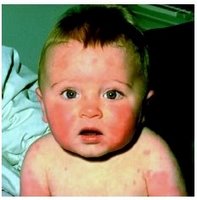Fifth disease (patient information)
For the WikiDoc page for this topic, click here
Editor-in-Chief: Ethan Leeman
Please Join in Editing This Page and Apply to be an Editor-In-Chief for this topic: There can be one or more than one Editor-In-Chief. You may also apply to be an Associate Editor-In-Chief of one of the subtopics below. Please mail us [1] to indicate your interest in serving either as an Editor-In-Chief of the entire topic or as an Associate Editor-In-Chief for a subtopic. Please be sure to attach your CV and or biographical sketch.
What is Fifth disease?

Fifth disease, sometimes called Erythema infectiosum, is a mild rash illness caused by a viral infection that occurs most commonly in children. The ill child typically has a "slapped-cheek" rash on the face and a lacy red rash on the trunk and limbs. Occasionally, the rash may itch. An ill child may have a low-grade fever, malaise, or a "cold" a few days before the rash breaks out. The child is usually not very ill, and the rash resolves in 7 to 10 days.
What are the symptoms of Fifth disease?
- Characteristic red cheeks
- Red, lacy rash, often found on arms and legs
- Arthritis in older patients, sometimes causing trouble walking
- Low fever
- Cold symptoms
Who is at risk for Fifth disease?
Anyone can get Fifth disease. Once anyone has had it, they become immunized against the virus. Because the virus is so common, most people acquire immunity in childhood.
The disease is not very serious unless the person infected has conditions (problems with immune system, pregnancy, sickle-cell disease, anemia)
Diagnosis
A physician can often diagnose fifth disease by seeing the typical rash during a physical examination. In cases in which it is important to confirm the diagnosis, a blood test may be done to look for antibodies to parvovirus. Antibodies are proteins produced by the immune system in response to parvovirus B19 and other germs. If immunoglobulin M (IgM) antibody to parvovirus B19 is detected, the test result suggests that the person has had a recent infection.
Causes
Fifth disease is caused by infection with human parvovirus B19. This virus infects only humans. Parvovirus B19 has been found in the respiratory secretions (e.g., saliva, sputum, or nasal mucus) of infected persons before the onset of rash, when they appear to "just have a cold." The virus is probably spread from person to person by direct contact with those secretions, such as sharing drinking cups or utensils. A person infected with parvovirus B19 is contagious during the early part of the illness, before the rash appears. By the time a child has the characteristic "slapped cheek" rash of fifth disease, for example, he or she is probably no longer contagious and may return to school or child care center. This contagious period is different than that for many other rash illnesses, such as measles, for which the child is contagious while he or she has the rash.
When to seek urgent medical care
Fifth disease is usually a mild illness that resolves on its own among children and adults who are otherwise healthy. Joint pain and swelling in adults usually resolve without long-term disability.
Parvovirus B19 infection may cause a serious illness in persons with sickle-cell disease or similar types of chronic anemia. In such persons, parvovirus B19 can cause an acute, severe anemia. The ill person may be pale, weak, and tired, and should see his or her physician for treatment. (The typical rash of fifth disease is rarely seen in these persons.) Once the infection is controlled, the anemia resolves. Furthermore, persons who have problems with their immune systems may also develop a chronic anemia with parvovirus B19 infection that requires medical treatment. People who have leukemia or cancer, who are born with immune deficiencies, who have received an organ transplant, or who have human immunodeficiency virus (HIV) infection are at risk for serious illness due to parvovirus B19 infection.
Occasionally, serious complications may develop from parvovirus B19 infection during pregnancy. Hydrops fetalis may occur, causing spontaneous abortion.
Treatment options
Treatment of symptoms such as fever, pain, or itching is usually all that is needed for fifth disease. Adults with joint pain and swelling may need to rest, restrict their activities, and take medicines such as aspirin or ibuprofen to relieve symptoms. The few people who have severe anemia caused by parvovirus B19 infection may need to be hospitalized and receive blood transfusions. Persons with immune problems may need special medical care, including treatment with immune globulin (antibodies), to help their bodies get rid of the infection.
Diseases with similar symptoms
Where to find medical care for yourdisease
Directions to Hospitals Treating XXX
Prevention of Fifth disease
There is no vaccine or medicine that prevents parvovirus B19 infection. Frequent handwashing is recommended as a practical and probably effective method to decrease the chance of becoming infected. Excluding persons with fifth disease from work, child care centers, or schools is not likely to prevent the spread of the virus, since people are contagious before they develop the rash.